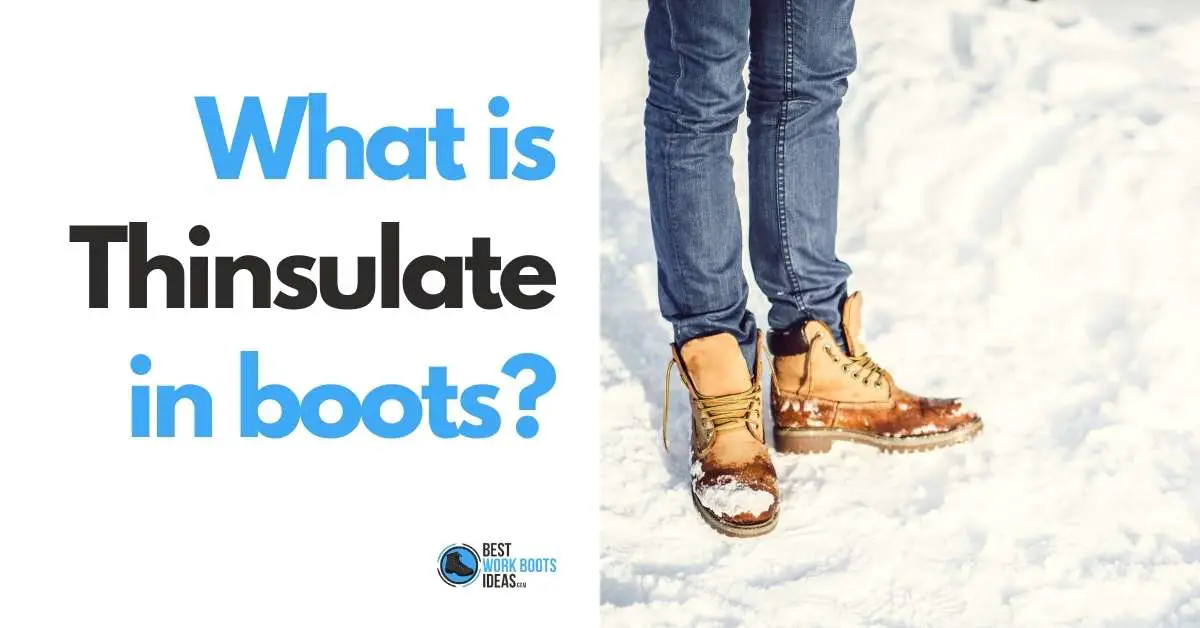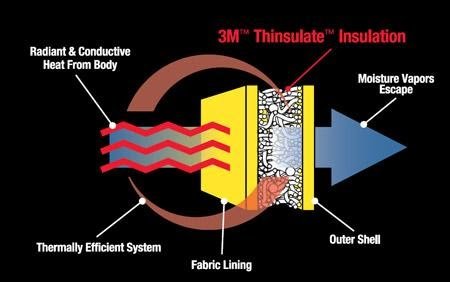What is Thinsulate in Boots: How do your your feet stay warm in the coldest of weather?

Many jobs that require work boots also require you to spend time in challenging weather.
Fortunately, there are industries focused on creating gear so workers can spend their days outside in comfort.
The products are very specific, and cater to the exact needs of workers.
One of these materials you might have seen is a 3M product called Thinsulate.
In this article I’ll get into what Thinsulate is and why it’s established itself as the gold standard of insulation in work boots.
As a younger man I worked three cold months without properly insulated boots.
It’s miserable, painful, and was absolutely a representation of my youthful foolishness.After a season of telling myself I was really tough, by January I told myself the truth: I was suffering unnecessarily.
I grabbed a pair of boots insulated with Thinsulate and never looked back.
So I’ve known about Thinsulate for years, but never exactly what it was or how it worked.
I got this topic while researching exactly those unknown details, I first turned to 3M, the manufacture of the material.
To my surprise, 3M didn’t provide all the data I wanted to see; fortunately, the US Military did.
They were a wealth of very detailed scientific research.
I learned a lot about the properties of insulating materials when wet verses when dry.
I also added to my knowledge of how debilitating foot injuries caused by cold (Non Freezing Combat Injury – NFCI) can be; only 15% of American soldiers suffering NFCI ever returned to combat in WWII!
How’s that for encouragement to keep your feet warm?
The bottom line: If you work in the cold, this article is for you.
It’s worth taking care of your body, live to fight another day. Stay warm, dry, healthy, and working, by grabbing a pair of boots built with Thinsulate.With that, let’s detail what Thinsulate is.
Contents
What is Thinsulate Insulation?
Thinsulate is a synthetic fiber developed by 3M that insulates better than any natural materials on earth.
3M’s goal when developing Thinsulate was to provide an alternative to down, which is bulky, natural, and therefore more expensive to obtain.
Unlike down, which requires harvesting from geese, ducks, or other birds, Thinsulate is man made, so the production process is much simpler.
Additionally, it’s lighter, more compact, and according to 3M, twice as effective as down in retaining heat. The fact that it’s more compact than down makes it the perfect material to insulate boots.
There isn’t much extra room in a boot as it is, and no one wants to make their boots heavier and bulkier when there’s a better solution available. Besides boots, you’ll find Thinsulate in gloves, jackets, fire fighting equipment, acoustic insulation, and many more applications.
You might have something that is built with Thinsulate and not even know it.
Just in case you have doubts about whether or not Thinsulate is the real deal, the US Military has done extensive testing of cold-weather boots.
They’ve discovered it’s effectiveness in the toughest of conditions. Let’s continue on and get into the specifics of how Thinsulate works.
How Does Thinsulate Work?

Thinsulate, a synthetic insulation, works in the same way a wetsuit does, only with air instead of water.
Thinsulate is made of microfibers that are smaller (15 micrometers) than polyester, and are woven so closely that they create a barrier against air.
There is a gap between the liner of your boots and the Thinsulate, this allows your feet to act as a furnace and heat the air trapped in the pocket.
At that point, the heated air circulates back to the feet, is replaced by colder air, continuing the cycle to prevent and therefore preventing any heat loss.
If this sounds like the recipe for dampness, there’s no need to worry.
Thinsulate is extremely breathable and lets moisture escape while trapping the air.
It’s siliconized fibers are hydrophobic and absorb less than 1% of their weight of water.
Perhaps this all seems a bit too heady, we’re just talking about insulated boots, right?
Yes, but there’s a lot of science and research that has gone into making insulated boots that hold up in all conditions!
The US Military has done numerous studies (yes I found yet another one), on what happens when boots get wet.
When your boots get wet and hold on to the water, they stop insulating your feet as well.
A regular boot loses 38% effectiveness, whereas boots with Thinsulate only lose around 5%.
That’s quite a difference!
Are There Different Levels of Thinsulate insulation in boots?
Yes, there are different levels of Thinsulate.
This is a little tricky to give a completely clear answer as to what you need as 3M doesn’t exactly say ‘you need this much Thinsulate for this temperature.’
Even that being the case, there’s a rough scale you can use to determine what level of Thinsulate you need.
| Level of Thinsulate Insulation (in grams) | Description |
|---|---|
| 200 grams | Suitable for autumn days in a temperate climate while doing high levels of activity |
| 400 grams | A little colder, getting closer to winter, perhaps a little less activity. This is the ideal amount for footwear in terms of performance. |
| 800 grams | Looking at temperatures around or slightly below freezing. This is when you really start to get cold feet. |
| 1200 grams | When you’re dealing with temperatures that are consistently below freezing, you’ll want insulated footwear with around 1200 grams of Thinsulate |
| 2000 grams | Truly Arctic conditions that will remain constant throughout the day and night. For those working the least hospitable environments. |
3M notes that there are many variables that increase or decrease the warmth of a particular boot.
3M manufactures the insulation, not the boot itself, so they can’t be held responsible for exactly how their product will perform within another company’s product
To get the boot that suits your environment best you should speak with the sales person or reach out to a manufacturer directly.
It’s actually quite easy to get answers from boot manufacturers in the digital age, I do so regularly when inquiring about the specs on a particular product.
Just go to their website and send an email, you’ll usually have an answer within an hour or two.
Insulated From Bad Intel
That’s what Thinsulate is all about.
It’s no longer a new technology so there are Thinsulate ‘knock offs’ that claim to deliver the same results.
I’m not sure if that’s true or not, I’ve always just gotten the boots that had Thinsulate.
When buying a product, I always consider the history and reputation of the manufacturer.
3M isn’t paying me to write this (I mean, they probably should with how hard I repped their product), but I’ve always liked the things that they make.
From masks, heavy duty respirators, to the Post-It notes I just realized were sitting on my desk, to my orbital sander, to sandpaper, to the….etc.
Oh and if you’re as old as me, you’ll even remember the floppy 3.5 inch disks that 3M used to make….I digress!
They make products that work, and I have found Thinsulate to be no exception to that experience.
If you work in cold weather, need footwear where boot insulation is important but don’t fancy wearing multiple pair of socks, 3M Thinsulate is a really good choice.
You might also be interested in knowing about insulated work boots.
